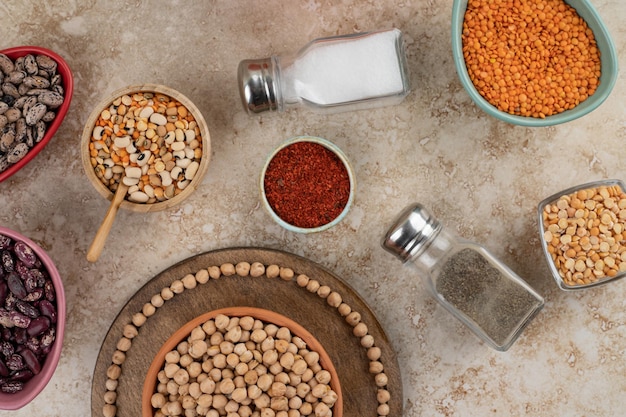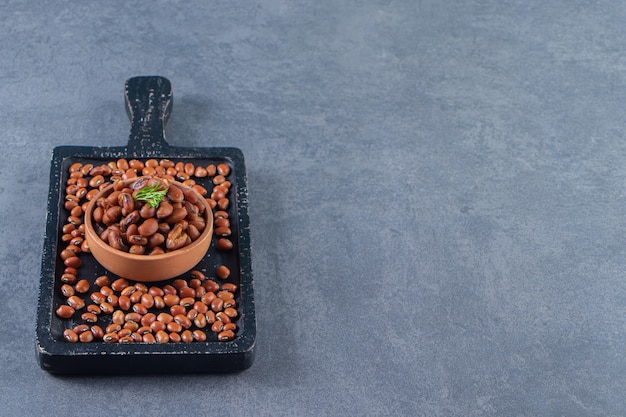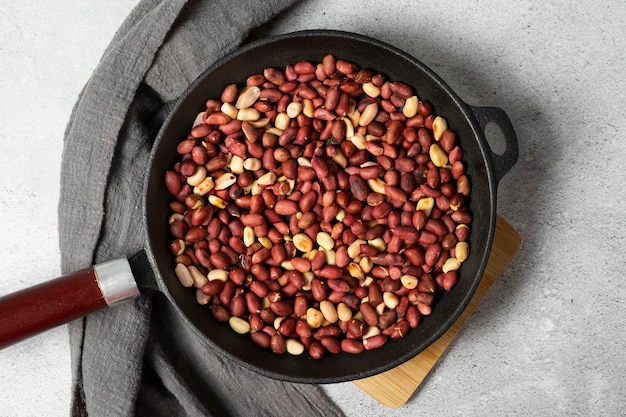dried beans are a kitchen staple, offering a hearty, delicious, and budget-friendly protein source. I've been a bean enthusiast for years, and I've learned a thing or two about getting them just right. This guide is for everyone, from beginners to seasoned cooks, aiming to make your bean-cooking journey smoother and tastier. We'll delve into everything from choosing the right beans to mastering the perfect cooking technique and even throwing in some recipe inspiration along the way. Let's dive in!
(Part 1) Choosing the Right Beans: A Bean Connoisseur's Guide

Just like choosing the perfect wine for a meal, picking the right beans is crucial for achieving the best results. It's not just about grabbing the first bag you see; it's about understanding the nuances of each bean variety and selecting the one that best suits your dish.
The Bean Family: A Diverse and Delicious World
The world of dried beans is wonderfully diverse, offering a plethora of flavours and textures to tantalize your taste buds. Let's explore some of the most popular varieties:
- black beans: These beans are absolute superstars in the culinary world! They boast a firm texture, a deep, earthy flavour, and hold their shape beautifully, making them perfect for salsas, dips, and hearty stews. They're also a fantastic source of fiber and iron.
- kidney beans: These larger beans have a slightly sweet flavour and a tender texture. They're an absolute must-have for chilli, salads, and baked dishes. They're also high in protein and iron.
- pinto beans: Pinto beans have a pale, speckled appearance and a mild flavour that's both creamy and satisfying. They're a staple in Mexican cuisine, lending their deliciousness to burritos, dips, and refried beans. They're also a good source of fibre and folate.
- Chickpeas: Also known as garbanzos, these beans are incredibly versatile and can be used in a wide range of dishes. They're a star ingredient in curries, salads, and even hummus. They're also a good source of protein and fibre.
- Lentils: Lentils are small, quick-cooking legumes that have a rich, nutty flavour. They're perfect for soups, stews, and salads, adding a hearty texture and a delightful flavour to your creations. They're also a great source of protein and iron.
Picking the Perfect Beans: A Guide to Spotting the Best
Once you've decided on your bean variety, it's time to choose the perfect bag. Here are a few tips to ensure you get the best beans:
- Look for bright, evenly coloured beans. Avoid any that are discoloured, shriveled, or have any signs of insect damage. A fresh bag of beans should look vibrant and uniform.
- Check the packaging date. Beans, like most dried goods, tend to lose flavour and freshness over time. Choose bags with a more recent date for the best taste.
- Don't be afraid to experiment! The bean world is vast, and there are so many delicious varieties to try. Don't be afraid to step outside your comfort zone and try something new. You might discover your next favourite bean!
(Part 2) Prepping Your Beans: Setting the Stage for Success

Before you can start cooking, your beans need a little TLC to ensure they're ready for their culinary transformation. This prepping step is crucial, as it helps remove any impurities, improves their texture, and makes for a more enjoyable cooking experience.
Washing and Sorting: A Clean Slate for Your Beans
First things first, give those beans a good rinse. Dump them into a colander and run cold water over them. This removes any dust, debris, or tiny critters that might be hiding among the beans. Then, give them a close look-over. Pick out any damaged, discolored, or shriveled beans. You want only the best beans in your pot!
Soaking: A Game-Changer for bean cooking
Soaking is a topic that sparks much debate among cooks. I'm a firm believer in soaking my beans, and I'll tell you why. Soaking reduces cooking time, helps soften the beans, enhances their digestibility, and makes them less gassy! It's a win-win all around.
To soak your beans, simply place them in a large bowl or pot, cover them with plenty of cold water, and let them sit for at least 4 hours, or overnight. I usually soak my beans overnight to give them plenty of time to plump up. Just remember to change the water after a few hours to prevent any funky smells.
Soaking Alternatives: When Time is Short
Life gets busy, and sometimes soaking just isn't feasible. Fear not! There are a few alternatives that can help you achieve perfectly cooked beans without the overnight soak.
- The Quick Soak Method: This method involves bringing the beans to a boil, then simmering for 1 minute before letting them soak for 1 hour. It's a great option for those who need their beans quicker.
- Pressure Cooking: pressure cookers are a kitchen game-changer for beans. They reduce cooking time significantly, and they often produce incredibly tender beans. Just be sure to follow the manufacturer's instructions carefully for safe and effective cooking.
(Part 3) The Art of Bean Cooking: A Culinary Symphony

Now comes the fun part - cooking those beans! This is where your culinary creativity truly shines. A little bit of love and attention can transform those humble legumes into a symphony of flavour.
Stovetop Cooking: A Classic Approach
Stovetop cooking is a tried-and-true method that I've used for years. It's simple, reliable, and produces consistently delicious results. Here's the basic process:
- Add your prepped beans to a large pot with a lid. Cover them with about 2 inches of fresh water. Don't overcrowd the pot. Give those beans some space to move around.
- Bring the mixture to a rolling boil, then reduce the heat to a gentle simmer. Cover the pot and let the beans simmer gently for the recommended time, depending on the type of bean. I usually check the beans after about an hour and give them a taste test to see if they're tender.
- Add a pinch of salt towards the end of the cooking time. Adding salt too early can make the beans tough.
Tips for Perfect Stovetop Beans: From Pro to Pro
- Use plenty of water. The water should cover the beans by at least 2 inches. This ensures they cook evenly and prevents them from sticking to the bottom of the pot.
- Skim off any foam that forms on the surface. This foam can make the beans taste a bit bitter.
- Add a bay leaf or two for extra flavour. Bay leaves lend a lovely earthy aroma to beans, adding another layer of complexity to their flavour.
(Part 4) bean cooking times: A Timetable for Success
Every bean has its own unique personality, and that includes its cooking time. This handy guide will help you determine the perfect cooking time for your favourite beans:
| Bean Type | Cooking Time (Stovetop) |
|---|---|
| Black Beans | 1-1.5 hours |
| Kidney Beans | 1-1.5 hours |
| Pinto Beans | 1-1.5 hours |
| Chickpeas | 1-1.5 hours |
| Lentils | 20-30 minutes |
These are just estimates, as cooking times can vary depending on the age of the beans, your altitude, and the type of pot you're using. The best way to determine if your beans are done is to taste test them. They should be tender but not mushy. If they're still a bit firm, just continue cooking for a few more minutes.
(Part 5) Mastering the Flavour: Bean Seasoning
Now that your beans are cooked to perfection, it's time to unleash your creativity! This is where you add the final touches of flavour that will elevate your bean dish to new heights.
Classic Flavour Combinations: A World of Possibilities
- Mexican: Cumin, chili powder, garlic, onion, and a touch of lime juice. These spices create a vibrant and aromatic flavour that's perfect for Tex-Mex dishes.
- Mediterranean: Lemon juice, olive oil, oregano, garlic, and a pinch of red pepper flakes. These ingredients offer a bright, tangy flavour profile that pairs beautifully with Mediterranean cuisine.
- Indian: Curry powder, turmeric, ginger, garlic, and a splash of coconut milk. These spices create a warm, complex flavour that's perfect for Indian curries and stews.
- BBQ: Smoked paprika, garlic powder, onion powder, and a dash of brown sugar. These flavours evoke the smoky, sweet notes of traditional barbecue sauces.
Tips for Seasoning Beans: A Guide to Balanced Flavour
- Don't overseason! Beans have a delicate flavour, and too much seasoning can overwhelm them. Start with a small amount and taste as you go, adding more if needed.
- Consider adding a bit of acidity like lemon juice, lime juice, or vinegar to balance the flavour. Acidity adds brightness and complexity to the overall flavour profile.
(Part 6) bean recipes: Inspiration for Every Occasion
With your newfound bean-cooking skills, it's time to get creative! Beans are incredibly versatile and can be incorporated into a wide array of dishes. Here are some ideas to get your creative juices flowing:
Hearty and Satisfying: comfort food Classics
- black bean soup: A classic comfort food that's perfect for a chilly evening. It's packed with flavour, protein, and fiber, making it a satisfying and healthy meal.
- Chilli: A hearty and flavourful dish that's perfect for a crowd. It's a staple for potlucks and gatherings, and it's always a crowd-pleaser.
- Bean Stew: A delicious and satisfying meal that can be made with a variety of vegetables and meats. It's a great way to use up leftover ingredients and create a nourishing and comforting dish.
- Burrito Bowls: A customizable and healthy meal that's perfect for lunch or dinner. You can create your own unique combination of beans, rice, veggies, and toppings for a meal that's both delicious and satisfying.
Fresh and Light: Flavourful and Healthy Options
- bean salad: A refreshing and healthy side dish that's perfect for potlucks and picnics. It's packed with protein, fiber, and flavour, making it a healthy and satisfying addition to any meal.
- lentil salad: A protein-packed salad that's both delicious and nutritious. It's a great way to enjoy lentils in a lighter, more refreshing way.
- Bean Dip: A delicious and easy appetizer that's perfect for parties. It's a crowd-pleasing snack that's both flavorful and easy to make.
- Bean Burgers: A tasty and healthy alternative to traditional beef burgers. They're a great way to add a plant-based protein source to your meals, and they're surprisingly delicious.
(Part 7) Storing Your Bean Bounty: Preserving Your Culinary Creations
You've cooked a big batch of beans, and now you want to make sure you can enjoy them for days to come. Here's how to store them properly to keep them fresh and delicious.
Refrigerating Cooked Beans: Short-Term Storage
Cooked beans can be stored in the refrigerator for up to 5 days. Simply transfer them to an airtight container and store them in the fridge. This will keep them fresh and ready to use for your next culinary adventure.
Freezing Cooked Beans: Long-Term Storage
For longer storage, you can freeze your cooked beans. To freeze, simply place them in a freezer-safe container or bag, leaving some space for expansion. Cooked beans can be frozen for up to 3 months. Just be sure to label them with the date to keep track of their freshness.
Reheating Beans: Bringing Back the Flavour
When you're ready to enjoy your stored beans, simply reheat them on the stovetop or in the microwave. I find that reheating beans in a little broth or sauce helps to keep them moist and flavorful. It also prevents them from drying out and becoming too dense.
(Part 8) FAQs: Bean-tastic Answers to Common Questions
Here are some of the most frequently asked questions about cooking dried beans:
1. Why do my beans taste gassy?
Gas is a common side effect of eating beans, but there are a few things you can do to reduce it. Soaking your beans before cooking can help to break down the sugars that cause gas. You can also try adding a pinch of baking soda to the cooking water. It's important to note that everyone's digestive system is unique, and some people may experience more gas than others when eating beans.
2. Can I use canned beans instead of dried beans?
Absolutely! Canned beans are a great convenience, and they can be used in many recipes. They offer a quick and easy option for those who are short on time or don't want to go through the process of soaking and cooking dried beans. However, canned beans often have a higher sodium content than dried beans, so be sure to check the label and adjust your seasoning accordingly.
3. How do I know if my beans are bad?
If your beans have a sour smell, or if they are discolored or moldy, it's best to throw them away. Always check the packaging date and avoid using beans that are past their expiration date. fresh beans will have a pleasant, earthy smell and a vibrant color. If you're unsure, it's always better to err on the side of caution and discard them.
4. What happens if I don't soak my beans?
You can cook dried beans without soaking them, but it will take longer, and the beans may not be as tender. The soaking process helps to soften the beans and make them more digestible. If you're in a hurry, you can try the quick soak method, which involves bringing the beans to a boil, then simmering for 1 minute before letting them soak for 1 hour.
5. How do I prevent my beans from becoming mushy?
Overcooking is the most common cause of mushy beans. The best way to prevent this is to cook your beans until they are tender but not mushy. You can also add a little bit of salt to the cooking water, which will help to firm up the beans. Remember, the goal is to achieve a tender but still firm texture.
And there you have it! You're now equipped with all the knowledge and tips you need to conquer the world of dried beans. Go forth and create delicious and satisfying bean dishes that will delight your taste buds and nourish your body. Whether you're a seasoned cook or just starting out, remember that cooking dried beans is a journey of discovery. Enjoy the process, experiment with different flavours, and embrace the wonderful world of beans!
Everyone is watching

Corn on the Cob: The Ultimate Guide to Perfectly Cooked Ears
Healthy MealsAh, corn on the cob. Just the name evokes images of sunny days, barbecues, and that sweet, juicy flavour that ...

Perfect Pork Roast Oven Cooking Time: A Guide to Delicious Results
Healthy MealsThere's something truly satisfying about a perfectly roasted pork. The aroma alone is enough to make your mout...

Ham Cooking Time: How Long to Bake, Smoke, or Boil a Delicious Ham
Healthy MealsAh, ham. It's a classic, isn't it? A real crowd-pleaser, especially around holidays. And when done right, it'...

Scallops: The Ultimate Guide to Perfect Cooking
Healthy MealsAh, scallops. Those delicate, sweet, and utterly delicious morsels of the sea. They hold a special place in my...

Spaghetti Squash: The Ultimate Guide to Cooking and Serving
Healthy MealsRemember that time you saw spaghetti squash at the supermarket, looking all bumpy and strange, and thought, "W...
